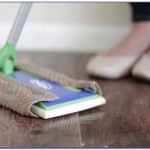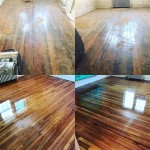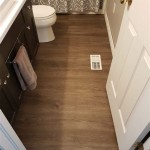How To Install Vinyl Tile On Concrete Basement Floor
Installing vinyl tile on a concrete basement floor can significantly enhance the aesthetic appeal and functionality of the space. A well-executed installation provides a durable, water-resistant, and easy-to-maintain flooring solution. However, the success of the project hinges on proper preparation, adherence to installation guidelines, and the use of appropriate materials. This article provides a comprehensive guide on installing vinyl tile on a concrete basement floor, covering crucial aspects from surface preparation to final finishing touches.
Assessing the Concrete Subfloor and Addressing Issues
The condition of the concrete subfloor is paramount to the longevity and performance of the vinyl tile installation. A thorough assessment must be conducted to identify any potential problems that may compromise the finished floor. This involves a visual inspection, moisture testing, and addressing any imperfections or damage.
Visual Inspection: Begin by thoroughly examining the concrete floor for cracks, holes, and uneven surfaces. Hairline cracks may be common, but larger cracks, especially those that are wider than 1/8 inch or show significant movement, require professional evaluation and repair. Look for signs of previous repairs, such as patches or leveling compounds, and assess their integrity. Pay close attention to areas near walls, pipes, and drains, as these are often susceptible to moisture issues or damage.
Moisture Testing: Concrete is porous and can absorb moisture from the surrounding soil, especially in basements. Excess moisture can cause adhesive failure, mold growth, and eventual tile delamination. Therefore, it is crucial to conduct moisture testing before proceeding with the installation. Several methods are available, including:
* Calcium Chloride Test (Moisture Vapor Emission Rate - MVER): This test measures the rate at which moisture vapor is emitted from the concrete surface over a 24-hour period. A specific amount of calcium chloride is placed in a sealed container on the concrete floor. After 24 hours, the weight gain of the calcium chloride is measured, indicating the moisture emission rate. Most vinyl tile manufacturers specify a maximum MVER that is acceptable for their products. Exceeding this limit requires the application of a moisture mitigation system.
* Relative Humidity (RH) Testing in Concrete: This test involves drilling small holes into the concrete slab and inserting RH probes. The probes measure the relative humidity within the concrete. Similar to the MVER test, manufacturers specify acceptable RH levels for their vinyl tile products. This test often provides a more comprehensive understanding of the moisture content within the concrete slab.
* Plastic Sheet Test: A simple and inexpensive test involves taping a square of clear plastic sheeting (approximately 18x18 inches) to the concrete floor and sealing all edges with duct tape. After 24-72 hours, inspect the underside of the plastic sheet for condensation. The presence of condensation indicates excessive moisture and the need for further investigation and mitigation strategies.
Addressing Imperfections and Damage: Once the visual inspection and moisture testing are complete, address any identified issues. This may involve:
* Crack Repair: Small hairline cracks can often be filled with a concrete crack filler. Larger cracks require more extensive repairs, such as routing out the crack and filling it with a flexible epoxy crack filler. Consult with a concrete repair specialist for significant structural cracks.
* Hole and Patch Repair: Holes and damaged areas can be patched with a concrete patching compound. Ensure the patching compound is compatible with the concrete and the vinyl tile adhesive. Follow the manufacturer's instructions for application and curing.
* Leveling: Uneven surfaces can be leveled with a self-leveling concrete underlayment. This product is poured onto the floor and spreads to create a smooth, level surface. It is crucial to follow the manufacturer's instructions for mixing, application, and curing. Ensure the self-leveling compound is compatible with vinyl tile adhesive.
After addressing all imperfections and completing the necessary repairs, thoroughly clean the concrete floor to remove dust, debris, and any contaminants that may interfere with adhesive bonding. A concrete grinder or scarifier may be needed for heavily soiled or contaminated surfaces.
Selecting Appropriate Materials and Tools
Choosing the right materials and tools is essential for a successful vinyl tile installation. This section outlines the key considerations for selecting vinyl tile, adhesive, and other necessary equipment.
Vinyl Tile Selection: Vinyl tiles are available in various styles, thicknesses, and wear layers. Choose a tile that is suitable for basement conditions, considering factors such as moisture resistance, durability, and foot traffic. Luxury vinyl tile (LVT) and luxury vinyl plank (LVP) are popular choices for basements due to their enhanced durability and realistic appearance. Pay close attention to the manufacturer's specifications regarding subfloor requirements and adhesive compatibility.
Adhesive Selection: Selecting the correct adhesive is crucial for ensuring a strong and lasting bond between the vinyl tile and the concrete subfloor. Choose an adhesive specifically designed for vinyl tile installation on concrete. Water-based adhesives are generally recommended for basement applications due to their lower VOC content and ease of cleanup. Refer to the vinyl tile manufacturer's recommendations for specific adhesive types and application methods. Consider factors such as moisture tolerance, open time, and curing time when selecting an adhesive. Some adhesives require specific trowel notch sizes for proper application.
Tools and Equipment: The following tools and equipment are essential for installing vinyl tile:
* Measuring Tape: For accurate measurements and layout planning.
* Chalk Line: For creating straight lines and establishing a reference grid.
* Trowel: With the correct notch size as specified by the adhesive manufacturer, for applying the adhesive evenly.
* Utility Knife or Vinyl Tile Cutter: For precise cutting of tiles to fit edges and corners.
* Rubber Mallet: For firmly seating the tiles into the adhesive.
* Seam Roller: For ensuring proper adhesion and a seamless appearance, especially for LVT and LVP.
* Spacers (Optional): For maintaining consistent spacing between tiles, particularly for square-edged tiles.
* Straight Edge: For guiding cuts and ensuring accuracy.
* Safety Glasses and Gloves: For protecting your eyes and hands during the installation process.
* Knee Pads: For added comfort while working on the floor.
* Vacuum Cleaner or Broom: For keeping the subfloor clean during installation.
Step-by-Step Installation Process
Following a systematic installation process is crucial for achieving a professional and long-lasting vinyl tile floor. This section outlines the key steps involved in installing vinyl tile on a concrete basement floor.
1. Layout Planning: Before applying any adhesive, plan the layout of the tiles to ensure a balanced and aesthetically pleasing appearance. Find the center of the room by measuring the length and width, and marking the midpoints on each wall. Snap chalk lines connecting the midpoints of opposite walls to create a center intersection. Consider the visibility of cut tiles along the edges of the room. Adjust the center point slightly if necessary to minimize the width of cut tiles or to ensure that they are symmetrically placed. Aim for cut tiles to be at least half the size of a full tile.
2. Adhesive Application: Begin applying adhesive in a manageable section, typically a quarter of the room at a time. Use the recommended trowel with the specified notch size to apply the adhesive evenly, holding the trowel at a 45-degree angle. Follow the adhesive manufacturer's instructions regarding open time (the amount of time the adhesive can remain open before the tiles are installed). Avoid applying adhesive to a larger area than can be covered within the open time.
3. Tile Placement: Carefully place the first tile at the center intersection of the chalk lines, aligning it precisely. Press the tile firmly into the adhesive, ensuring full contact. Continue laying tiles outward from the center, following the layout plan and maintaining consistent spacing (if using spacers). Use a rubber mallet to tap each tile gently, ensuring it is firmly seated in the adhesive. For tiles with directional patterns, ensure they are oriented correctly and consistently.
4. Cutting Tiles: When you reach the edges of the room or obstacles such as pipes or columns, measure and cut the tiles to fit. Use a utility knife or vinyl tile cutter to make clean, accurate cuts. For complex cuts around pipes or columns, create a template using cardboard or paper. Carefully cut the tile according to the template and test the fit before applying adhesive. Remember to leave a small expansion gap along the walls to allow for thermal movement.
5. Rolling and Seaming: After installing a section of tiles, use a seam roller to firmly press the tiles into the adhesive. This ensures proper adhesion and minimizes the appearance of seams, especially for LVT and LVP. Roll in both directions, paying particular attention to the edges of the tiles.
6. Cleanup: As you work, clean up any excess adhesive immediately with a damp cloth or sponge. Dried adhesive can be difficult to remove and may damage the surface of the tiles. Regularly vacuum or sweep the floor to remove dust and debris.
7. Curing: Allow the adhesive to cure fully according to the manufacturer's instructions before allowing heavy foot traffic or placing furniture on the floor. This typically takes 24-72 hours. Avoid washing the floor during the curing period.
8. Finishing Touches: After the adhesive has cured, install baseboards or trim along the walls to cover the expansion gap and provide a finished look. Install transition strips at doorways to create a seamless transition between the vinyl tile floor and adjacent flooring materials.

How To Install Vinyl Plank Flooring On Concrete Step By Guide

Concrete Subfloor Preparation For The Vinyl Floor Installation How To Diy Mryoucandoityourself

Tips For Installing Vinyl Plank Over Concrete Floors Lemon Thistle

How To Install Vinyl Plank Flooring On Concrete Step By Tutorial

Best How To Install Vinyl Plank Flooring Four Generations One Roof
:max_bytes(150000):strip_icc()/can-you-install-tile-directly-on-concrete-1822600-04-458f7bb6c78348c1835cf8054ef36553.jpg?strip=all)
How To Install Tile Over Concrete

Vinyl Plank Flooring On Concrete Basement Pros Cons

Vinyl Plank Flooring On Concrete Basement Pros Cons

How To Prepare A Concrete Floor Lay L Stick Vinyl Flooring Help

Best How To Install Vinyl Plank Flooring Four Generations One Roof
Related Posts








